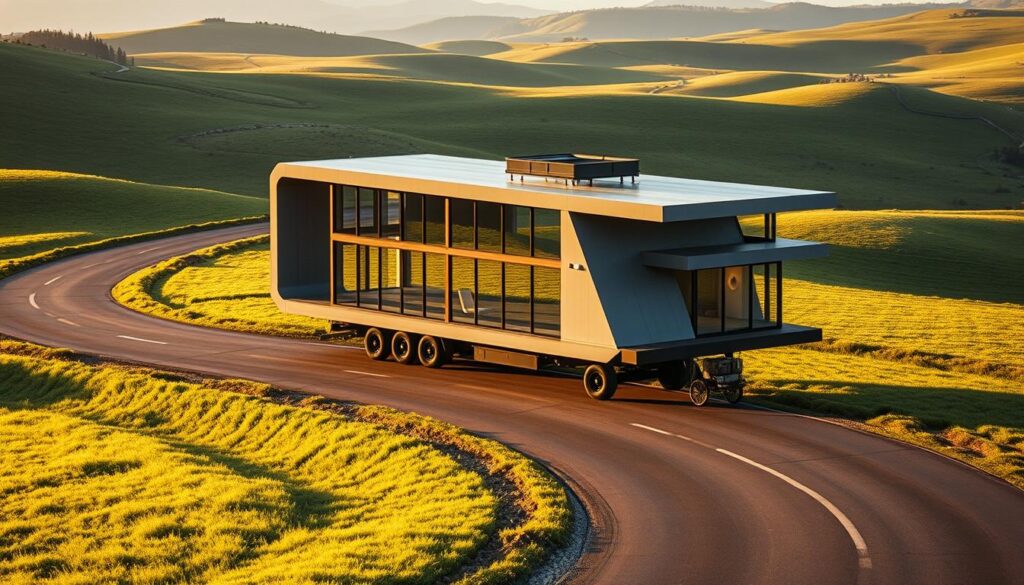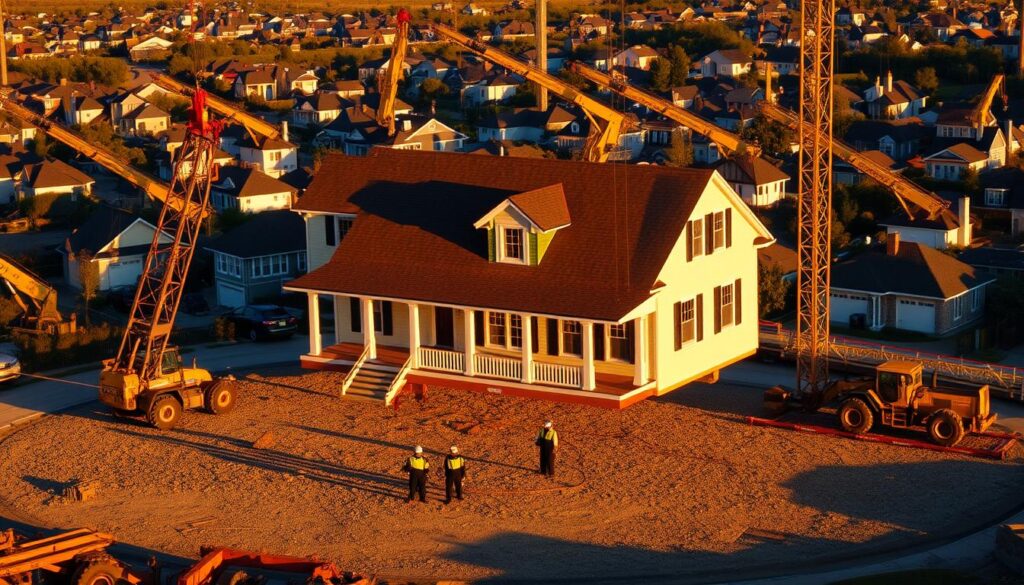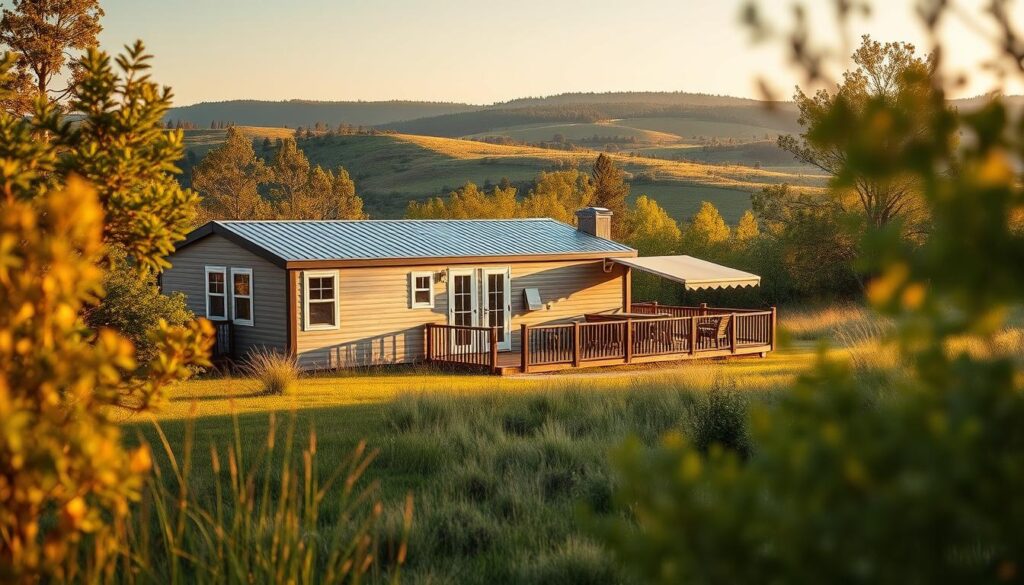Imagine a house that travels. Each year, homes like those from Mobile Architecture Innovations move to new places. House That Moves – These aren’t just trailers; they’re full-time homes built to travel.
From the Rocky Mountains to coastal California, these homes show that home can go anywhere. A family can eat in Colorado one month and garden in Arizona the next, all from the same house.

Mobile architecture combines engineering and creativity. It makes homes that can change and adapt. Think of walls that fold, solar panels that move, and floors that stay stable while moving, House That Moves.
Over 15,000 Americans live this way, choosing adventure over staying in one place. It’s not just travel; it’s a lifestyle where your home is your vehicle for exploring, House That Moves.
Key Takeaways House That Moves
- Relocatable homes offer year-round living without permanent ties to one location.
- Modern mobile architecture uses lightweight, durable materials to enable movement.
- These houses often include eco-friendly features like solar power and compact design.
- Over 10 states now have legal frameworks supporting annual house relocations.
- Costs start as low as $80,000 for base models, with custom options up to $500,000.
Introduction to A House That Moves to a New Location Every Year
Imagine a home that changes as easily as your dreams. Migratory living is more than a trend; it’s a new way of seeing shelter. House That Moves – These homes are designed to move with you, adapting to life’s ups and downs, House That Moves.
The Revolutionary Concept of Migratory Living
Migratory living turns the idea of a fixed home on its head. Nomadic architecture focuses on moving, with homes made to easily relocate. Picture a cabin that goes from snowy mountains to sunny beaches with the seasons—a growing favorite among families who love adventure, House That Moves.
Breaking Free from Traditional Housing Constraints
Relocatable housing means no more property taxes or long-term loans. House That Moves – It’s about having financial freedom. The perks include: no fixed location, lower upkeep, and the chance to follow new opportunities. Over 30% of people choose this for the cost savings, House That Moves.
The Rise of Nomadic Architecture in America
“A house should travel with you, not trap you,” says a 2023 survey by the American Mobile Living Association, highlighting growing demand for nomadic designs. Leading firms like WanderCraft Homes and Shift Architecture are at the forefront, creating small, transport-friendly homes. From Airstream-inspired bungalows to solar trailers, they show you can be mobile and comfortable at the same time.
Across the country, places like Arizona and Colorado are seeing more nomadic homes. Since 2021, sales have grown by 15% each year. This change isn’t just about practicality; it’s a new way of thinking about what “home” means, House That Moves.
The History and Evolution of Mobile Homes
Mobile living isn’t new. Humans have always looked for flexible shelter. The history of mobile homes starts with early settlers in America. They used wagons and covered carriages as homes, House That Moves.
In the 1900s, mobile homes got better. Companies like Airstream made sleek aluminum models in the 1950s. By the 1970s, HUD codes made them safer and more accepted. Now, they have solar panels and modular systems, showing they’re more than just temporary homes, House That Moves.
- 1900s: Prefabricated “house cars” for travelers
- 1930s: Mass production for Depression-era workers
- 1976: HUD safety standards established
- 2020s: Smart tech and eco-friendly materials
Trailers used to be seen as temporary homes. House That Moves – But now, they are permanent or seasonal. Innovators like William Taylor and companies like Thor Industries have made them better. From nomadic beginnings to today’s transportable buildings, mobile living has come a long way. Each era has brought new challenges, from war shortages to environmental concerns, House That Moves.
Architectural Innovation: How These Movable Houses Are Designed
Modern movable house design is a mix of creativity and engineering. It creates homes that can travel. Engineers work on four main areas: structure, modularity, materials, and foundations, House That Moves.
“Modular construction is the skeleton of relocatable living—it’s where flexibility meets function.”
Structural Requirements for Relocatable Buildings
Structures need to handle road vibrations and shifting loads. They use steel reinforcement and lightweight frames for stability during transport. Tests mimic real-world stresses to prevent damage, House That Moves.
Modular Construction Techniques
- Pre-assembled sections for easy disassembly
- Interlocking panels that align without custom fittings
- Quick-connect utilities for seamless reassembly
Materials That Make Movement Possible
Aluminum and fiber-reinforced polymers are used to cut weight. Companies like Modsy use these materials. They balance strength and mobility, House That Moves.
Double-glazed windows and insulating foam keep homes comfortable anywhere.
Foundation Systems for Temporary Placement
Temporary foundations like screw anchors or adjustable hydraulic piers secure homes quickly. These systems avoid long-term ground damage. They let homeowners relocate without leaving permanent footprints, House That Moves.
A QuickSet Foundation system, for example, takes hours to install instead of weeks.
The Logistics of Moving an Entire House
Moving a whole house needs careful planning and the right team. House That Moves – It’s all about the logistics. Let’s look at what’s involved:
Planning and Permits Required for House Relocation
First, you need permits. House relocation logistics start here. Local governments and utility companies check your plans. They make sure everything is safe and legal, House That Moves.
For example, the Federal Highway Administration handles big loads. City planners look at road closures. You’ll need to:
- Check the environment
- Disconnect utilities
- Notify neighbors

Transportation Methods and Considerations
There are different ways to move a house, depending on its size. You might use:
- Flatbed trailers for smaller homes
- Breaking down big buildings
- Rail systems in the countryside
Weather and road conditions matter a lot. Moving over mountains? House That Moves – Watch out for snow or rain. Companies like Jensen Relocation Solutions use GPS to avoid problems.
The Timeline of a Typical House Move
- 1–2 weeks: Get permits and approve routes
- 3–5 days: Prepare the house
- 1–3 days: Move the house
- 1–2 weeks: Put it back together and check it
“The most critical step is checking every permit. One missing approval can stall the move for months.” – Sarah Lee, Project Manager at HomeShift Logistics
It’s a big job, but modern tools help. With good planning, even long moves can go smoothly, House That Moves.
Financial Aspects: Costs and Savings of Relocatable Living
Moving a home isn’t cheap, but relocatable home costs can offer long-term benefits. The initial setup can start at $50,000 for a basic unit. Costs can go up with customization, House That Moves.
Transportation adds $2,000 to $10,000 per move, depending on the distance. Mobile home finances also include specialized insurance and maintenance for movable structures, House That Moves.
Yet, savings come in surprising ways. Unlike traditional homes, relocatable owners avoid fixed property taxes by rotating locations. House That Moves – This can save 20–30% annually on taxes alone.
Seasonal geoarbitrage lets users rent land in low-cost areas during off-seasons. This cuts long-term housing expenses. Smart climate tracking can also reduce energy use by 15%, lowering utility bills, House That Moves.
- Upfront costs: $50k–$200k for purchase and setup
- Annual savings: Up to $6,000 from tax and rent flexibility
- Financing options: Specialty lenders offer 8–12% interest loans tailored to movable property
While mortgages are rare for relocatable homes, leasing-to-own programs let buyers spread payments over time. Proper budgeting for fuel, permits, and repairs ensures movable house savings outweigh relocation expenses. For active travelers, the math often adds up to a financially adaptable lifestyle.
Environmental Benefits of Houses That Change Locations
Relocatable homes are more than just flexible. They also help the planet. These homes reduce waste and save natural spaces. Let’s see how they support a greener future.
Reduced Carbon Footprint Through Adaptive Reuse
Adaptive reuse is crucial for environmental benefits of relocatable homes. Unlike fixed structures, these homes don’t need to be torn down. A 2023 study found they cut emissions by 40% compared to new buildings.
By moving instead of rebuilding, they last longer without harming the environment.
Minimizing Land Impact Through Temporary Occupation
“Temporary occupation lets ecosystems recover,” says Dr. Elena Torres, a sustainable design expert. “Fields once hosting homes can regrow grass or host seasonal agriculture.”
Traditional homes change land forever. But, eco-friendly movable houses only occupy land temporarily. This lets soil and wildlife recover.
Farmers can even use these sites for crops between moves. This blends housing and agriculture in a sustainable way.
Energy Efficiency in Modern Mobile Homes
Today’s relocatable homes use smart technology to save energy:
- Triple-pane windows reduce heating needs
- Solar panels provide 70% of power
- Modular designs optimize natural light
| Aspect | Traditional Home | Relocatable Home |
|---|---|---|
| Energy Use | 15,000 kWh/year | 8,500 kWh/year |
| Carbon Emissions | 12 tons/year | 6.5 tons/year |
While moving has some emissions, the long-term savings are worth it. Sustainable mobile architecture is a smart choice.
Real-Life Stories: Families Living in Moving Homes
In the U.S., families in relocatable homes are changing what it means to live at home. The Johnson family from Colorado made their home into a trailer. “We’ve visited 14 states since 2020,” says Mark. “Our kids now map our next move on Google Earth.”
Their moving home lifestyle is all about the seasons and festivals. They have a special kitchen that goes outside.
“Freedom isn’t just about where you live—it’s about who you become along the way.”
Lena Torres, a tech entrepreneur, moves every six months with her twin boys. Her caravan, made by NomadHaus, has a special divider. “We’ve partnered with schools in Austin and Portland for remote learning,” she says. Her story shows how to stay flexible and keep up with school.
These families face challenges like finding places to park and store things. But, new solutions like quick water hookups help. A Texas couple, the Greens, even made an app for families in relocatable homes. They share tips on parking and local rules. “Every stop teaches us resilience,” says Mrs. Green. “Our home isn’t a house—it’s a rolling adventure.”
Challenges and Solutions for Year-Round Relocation

Living on the move all year has its own set of relocatable home challenges. Weather extremes and keeping up with community ties are just a few. But, there are practical mobile living solutions for each problem. Let’s dive into these issues and how to overcome them.
Weather and Seasonal Considerations
- Extreme temperatures: Use insulated materials like those in Airstream trailers to regulate indoor climate.
- Storm risks: Reinforce roofs and anchor points with systems from manufacturers like Thor Industries.
- Seasonal timing: Plan moves during spring/fall to avoid peak weather hazards.
Community and Social Integration
Connecting with others is crucial. Many nomads use apps like Nomad List to find local meetups. A California resident shared: “Joining farmers’ markets and co-working spaces helps us stay grounded.”
“We use apps like Nextdoor and attend town events to feel part of the community,” says Sarah Miller, a full-time traveler since 2020.
Utilities and Services on the Move
| Utility | Challenge | Solution |
|---|---|---|
| Internet | Spotty rural coverage | Starlink satellite internet |
| Electricity | Power outages | Portable solar panels and generators |
| Address changes | P.O. boxes or virtual mail services like Earth Class Mail |
Planning ahead can turn nomadic housing obstacles into manageable steps. Many homeowners work with relocation firms like USA Movers to make moving easier. With the right tools and mindset, mobility becomes a flexible lifestyle, not a limitation.
The Future of Relocatable Architecture: Trends and Innovations
Technology is changing the future of mobile homes for the better. We’re seeing smarter, greener designs. Innovations like AI setup systems and solar roofs are making homes more accessible. Experts say these relocatable architecture innovations will change how we live and work.
- AI-guided design tools streamline customization
- Self-adjusting foundations adapt to any terrain
- Recycled materials cut environmental impact
“The next decade will see mobile homes become as tech-savvy as smartphones, blending convenience with eco-conscious design.”
| Trend | Description | Impact |
|---|---|---|
| Modular Power Systems | Built-in solar panels and battery storage | Cuts energy costs by 40% |
| Quick-Connect Walls | Magnetic panels for fast assembly | Cuts relocation time by 50% |
| Climate-Responsive Roofs | Roofs that tilt to track sunlight | Maximizes energy efficiency year-round |
Mobile housing trends are changing with our lifestyles. With more people working from home, there’s a need for homes that combine work and living spaces. Young people want homes that are flexible and easy to move, leading to the rise of tiny homes with smart technology.
Climate change is also driving changes in mobile homes. Areas facing extreme weather need homes that can quickly move to safety. By 2030, expect homes that can charge themselves on the road or even grow their own food. The future of homes is about being adaptable and ready for any challenge.
Conclusion: Is a Moving Home Right for Your Lifestyle?
Choosing a relocatable home means you value freedom over staying in one place. This lifestyle lets you explore new places and help the environment. But, it also needs careful planning.
Think about your job and family. Do they do well with change? Can you handle new friends or different weather?
Also, consider your budget and design preferences. Modern models are energy-efficient and easy to move. Check local laws and transportation costs to make sure it fits your plan.
Some people face issues like delayed utility setups or adapting to weather. But, others love joining nomadic communities. Look at online forums for tips on moving or traveling.
Start by comparing costs on platforms like RelocateHome.org. A relocatable home might be perfect for you, whether you’re a digital nomad or looking to save on housing.
FAQ
What exactly is a relocatable home?
A relocatable home, also known as a mobile or modular home, is built to move. It meets special structural needs for safe transport. Yet, it still offers the comforts of a regular house.
How often can I relocate my home?
How often you move depends on many things. This includes local laws, what you prefer, and moving logistics. Some people move every year, while others do it less often.
What are the financial benefits of living in a relocatable home?
Living in a relocatable home can save you money. You might pay less in property taxes since you’re not stuck in one place. You could also save on utilities by using energy wisely in different places.
What types of permits are needed for relocating a house?
Getting the right permits involves working with local officials. You’ll need permits for moving, building at your new site, and for disconnecting and reconnecting utilities.
How is the transportation of a relocatable home managed?
Moving a home involves special trucks made for modular homes. You have to think about road width, bridge heights, and weather to ensure a safe trip.
What kinds of materials are used in modern relocatable homes?
Today’s relocatable homes use advanced materials. This includes lightweight composites, good insulation, and eco-friendly stuff. These materials help the home move easily and save energy.
Are relocatable homes environmentally friendly?
Yes! They help the planet by being reused and needing less new building. They also use green tech like solar panels and insulation to cut down on carbon emissions.
How do families adapt socially when constantly moving?
Moving can be tough for families to make friends. But, many use online groups and local clubs to fit in. Keeping up with friends through routines helps too.
What should I consider before investing in a relocatable home?
Think about your lifestyle, money, work, and family needs before buying. Weigh the good sides, like being able to move and saving on energy, against the hard parts like moving and making friends.
What trends are shaping the future of relocatable homes?
New trends include better modular building, easy renewable energy use, and more people wanting to live in them. This is because of remote work and younger people’s views on owning homes.
Source link
- https://www.wolfehousebuildingmovers.com/house-building-moving/
- https://www.rocketmortgage.com/learn/what-to-do-when-you-move-into-a-new-home
- https://www.wolfehousebuildingmovers.com/cost-factors-to-move-building/
- https://www.dailytelegraph.com.au/lifestyle/parenting/we-moved-three-times-in-three-years-with-kids/news-story/27528c6d6c9228946f0329856823c659
- https://www.moneysavingexpert.com/mortgages/moving-house-checklist/
